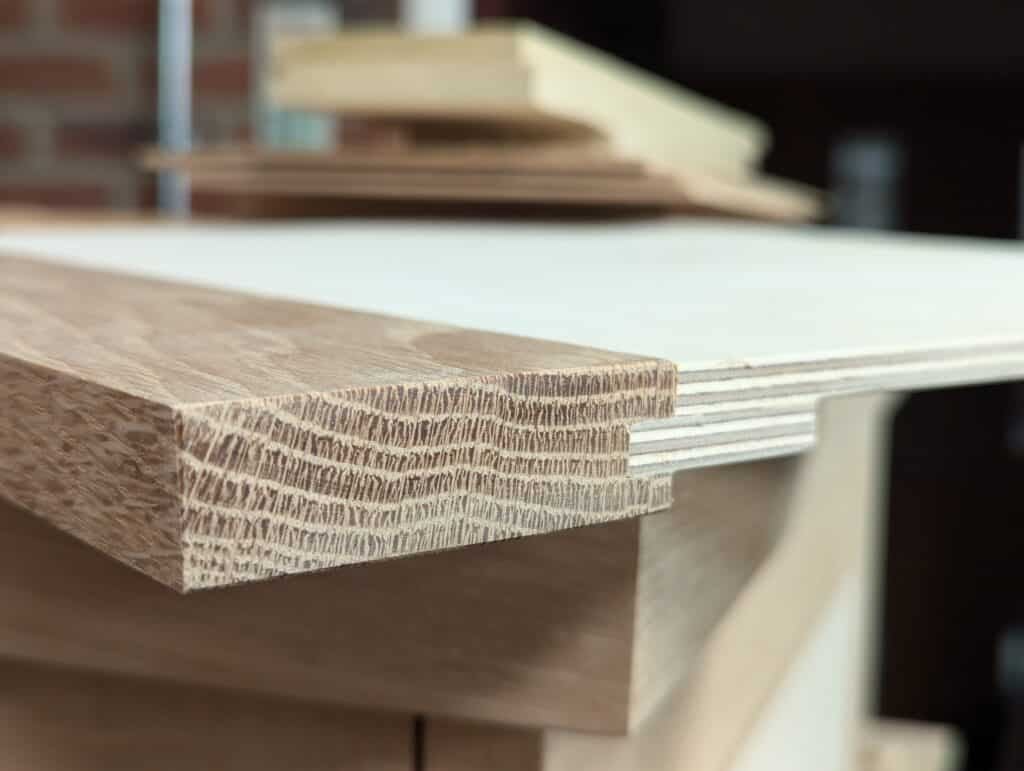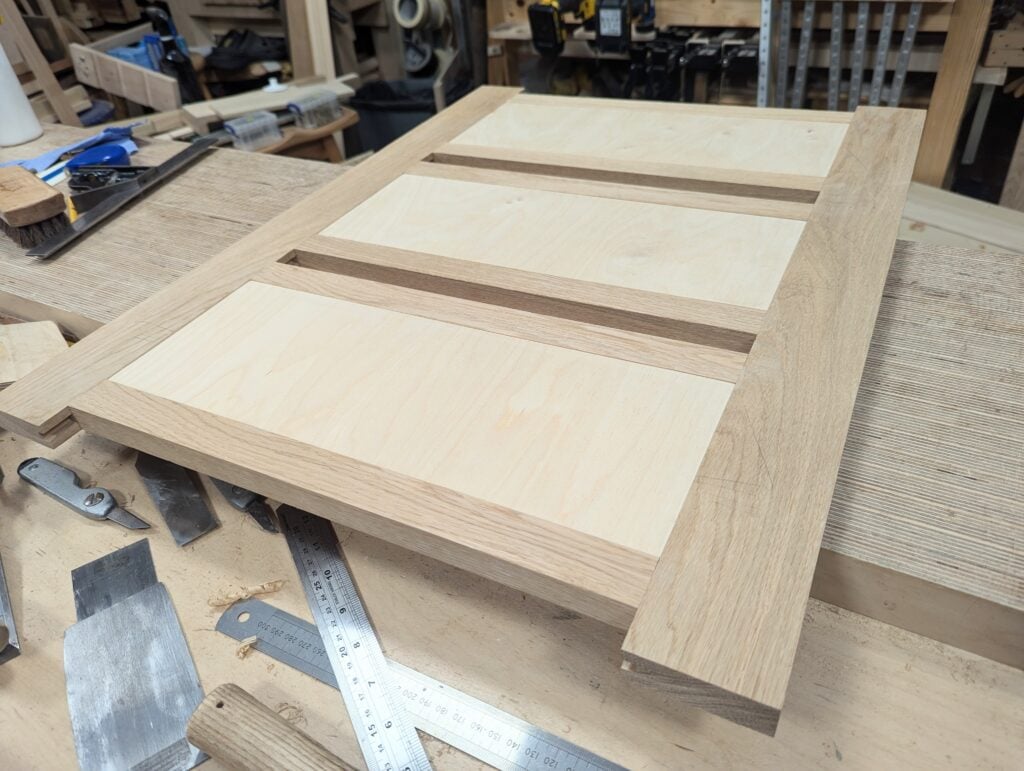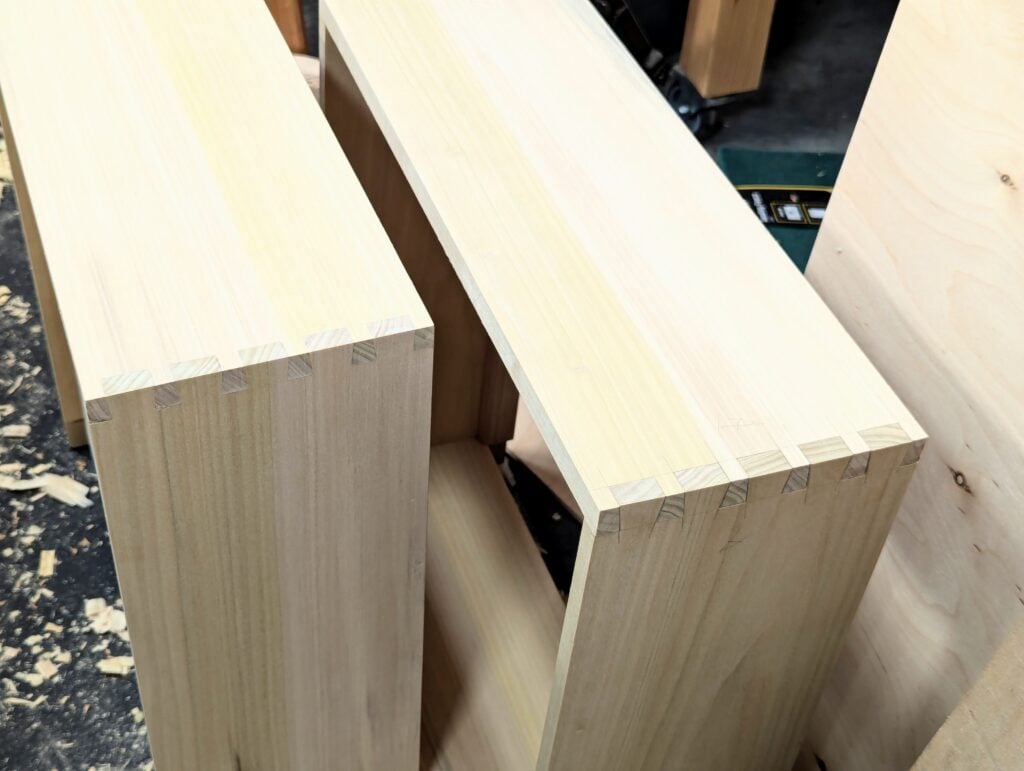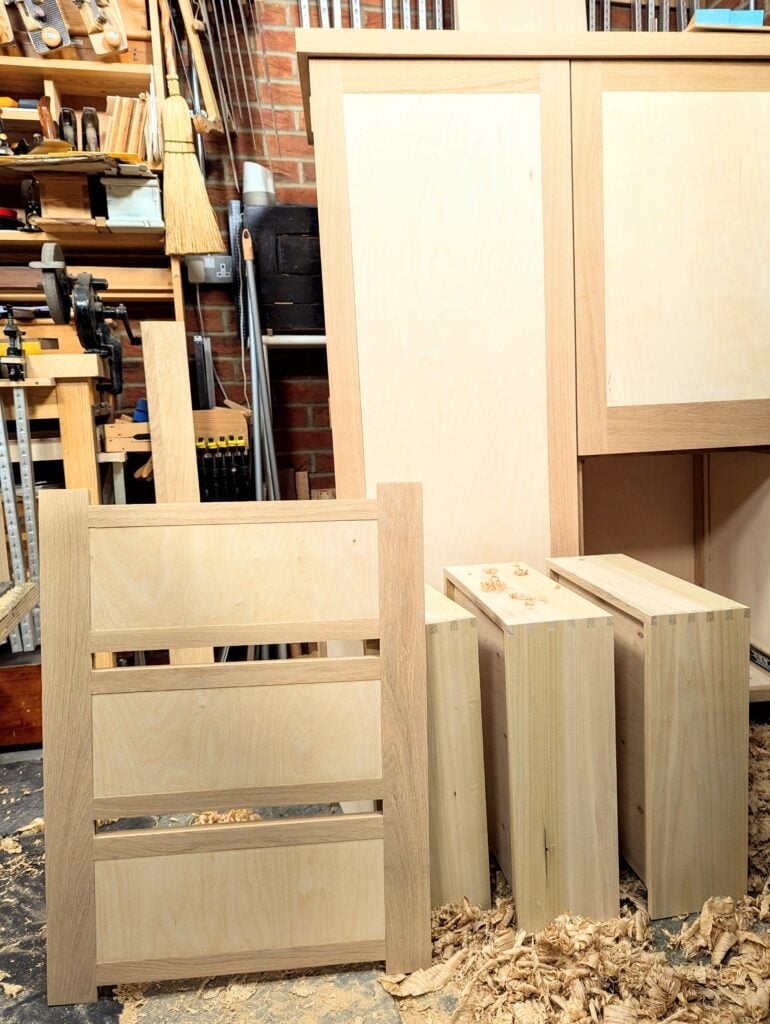Only Three Common Joints

I’m a traditionalist in some ways and a modernist in others, but I constantly strive never to compromise my own integrity nor the integrity of my work. What do I mean by that? Well, integrity affects many things. Going for cheap-quality and low-grade plywood would compromise the longevity of the pieces I make. Using solid wood in general guarantees that my pieces will last at least two-hundred years. The way I choose to work and the quality of my woodworking speaks of my own skillfullness, yes, but so too the how of how I make it. If you know me at all, you will have heard me say many times that ‘it is not what you make that’s important, but how you make it.‘ Working with hand tools is the most high-demand method of all woodworking bar none. And then there is the integrity of being true to yourself and your following too. From my experience of working with both hand tools and machines, I now use hand tools predominantly, but not to be in any way nostalgic or to lead people back into the dark ages. I do it because it is the best way to do woodworking and to engage with it with your whole being. Your whole being includes your mind, your emotions, every muscle, tendon and sinew that connects these to the work. The one thing from industrial carpenters from a job-site mentality or place of commerce is that machine methods using so-called power tools are faster and that you cannot make a living from working with hand tools. Well, I have news for them. I did, and I have, and I can, and that is because I don’t believe competitive pricing is everyone’s only criteria and more than that, we are not all trying to make anything to sell. It’s of equal importance to see too that most carpenters in industry do not own the skills to use hand tools, and with each generation that gets less and less. But in our amateur realms, people working with hand tools and owning mastered skills is always increasing.

Back in the 1980s, before many of you were born, I concluded that with three joints, traditional ones, and ten hand tools you could make just about anything from wood. I wasn’t far wrong. I have spent the last 15 years making 99% of the furniture I have been teaching you how to make, using 99% hand tools only. Furthermore, I have lived by what I have taught and preached and never strayed.

Here is my very latest design. It’s my version of a flat-pack disassemblable piece of furniture for clothes storage (or art and craft work, children’s awkward toys of all shapes and, believe it or not, it’s easy to make. I don’t too much care if you make it by hand or use some other method, but what I care about is teaching you to embrace innovative approaches and creative thinking by using traditional hand tools and the advice of someone skilled enough to redirect your path to better ways of working your wood be that solid or plied. Don’t cheat yourself out of mastering what you set out to do. I am not a gifted woodworker, I am an ordinary one. Yes, I am just a manual worker. So you can have what I have had for 60 years, too.
And I’d also like you to step away from the 1980/90s pallet wood and scaffolding planks along with your power equipment to see just what can be made with ten hand tools only. And if you doubt what can indeed be made primarily using quite basic hand tools, look at this that Team-Paul put together to show 30 or so pieces that we have made over the last decade or so doing just that. Here’s the link.

This new cabinet takes standard plywood and oak boards from the ordinary into the extraordinary with no real issues and zero compromise. The design is pure innovation, and the methods used can be adapted and adopted to make many more pieces. Now look at how I constructed the drawer fronts. Notice the stiles, how I split the wide six-inch oak board down its length to get my nicely matched grain, not book matched, intentionally not, to have good grain configuration and colour balance on each side. See the face grain of the plywood panels in the three drawer fronts that are yet to be separated. The grain aligns nicely because I used the same board but crosscut them to create sequential panels. This was very simple to do. It’s a technique. It’s my technique. One I developed just for this project. Yes, I know that some will say I do this all the time, but I doubt very much that they do.
Imagine! The basic common dovetail joint used for all boxes and drawers, the common housing dado used for bookshelves and the drawer backs of drawers and last but far from least, the most common of all frame joints, the basic mortise and tenon joint. These are the three very basic woodworking joints I used to make this piece. How on earth can that be?
My work is far from done yet. If you continue to support me, I will always support your endeavour to become masters of your own destiny in woodworking with hand tools.


I’m 76, to me the essential woodworking ‘tool’ is to be warm and dry. Everything is is a pleasure,I enjoy reading and looking at your ‘stuff’.
Hi, Mr Sellers would you ever hold an event where we can personally learn along side of you again. It great watching your videos and reading your blogs can learn a lot and have learnt a lot, it would be nice to have you looking over my shoulder and directly telling me of my flaws and where I could improve.
Thanks
Mr Glover
A promise to the future from a man whose work has never compromised him! Bravo to you Paul, from a longtime admirer!
Paul, I watched your YouTube video on making a plane tote over the weekend, over 3 sessions! I don’t need a plane tote* but I learnt a several things by watching you, so thank you for that 🙂
It’s interesting and instructive to watch you in action 🙂 . The closest I will get to an apprenticeship at my age! 🙂
*(hmm actually I repaired the split tote of my father’s Marples #4 a few years ago, perhaps that could be improved by replacement! I am less precious about this plane than one might expect because I recall my father using a blue Stanley #4 plane in my youth, rather than the red Marples! :D. How & why that changed, I’m not sure!).
I’ve tried to keep an open mind about this project’s use of plywood as the primary show surface. Having lived with it for a few weeks, I’m afraid I just can’t get there, Paul.
For me, this choice consigns the cabinet’s design — a clever one, indeed — to a utility category suitable for a shop or garage or the like but not for bedrooms or other living areas. If memory serves, your presentations have used plywood as drawer bottoms and furniture backs until this project.
I raise these points in part because your post mentions being true to your following. You are clearly the leader of the group. Paul, are you suggesting with the choice of plywood as a show surface that you want your subscribers to consider this as a valid aesthetic choice for “upstairs” furniture?
I have the highest respect for you and your work. I’m not just trolling here, Paul. I’d very much like to know how you feel about this use of plywood.
You don’t say where you live, Woody, but I’ll take a stab and say the USA. There are two things I have come to dislike over the past decade or two. Stains and mouldings. I recognise that some woods are truly bland, as might be the case in my use of birch. Maple is mostly bland, but for night on a century manufacturers have been staining maple to replicate the colour of other woods for their kitchen choices. Mouldings are used to decorate and to hide, and also, so people can use their power routers and justify having them. I would design a whole suite of pieces using the birch plywood upstairs or down, Woody, with no problem. I once owned a birch plywood dining table.
I don’t employ stain or moldings either, Paul. That is an aesthetic we share, and, yes, I live in the USA. Sounds like we part ways, amicably I hope, when it comes to plywood as a show surface. If I go to the trouble to make “upstairs” furniture, I’d almost certainly use solid wood. Until this Sellers Home project, I think you’ve used solid wood for parts people are likely to see in daily use. Hence my curiosity about your opinion on the topic. Thanks for clarifying.
I have heard many craftsmen echo your sentiments about moldings being used to hide gaps or cover poor workmanship. Recently I started making my own moldings by hand using molding planes made by another craftsman. It has opened yet another dimension to my woodworking habit. I have studied 17th century moldings in museums, books and antique establishments and talked with several people about how to use them to enhance a piece. They have added another dimension to my work.
In short I have changed my opinion of how they can be used.
Woody, plywood is available in a range of facing veneers, would you not consider for instance oak face ply with oak frame rather than the birch, would you still be resistant to this?
Thanks Paul. I’ve spend a great deal of time thinking about there are really only three joints (dovetail, mortise and tenon, and housing dado). Other joints seem to be “derivatives” of those when all is said and done. Once you realize that, things feel much more simple.
As for dovetails, even if you could find an alternative, why would you? The one think non-woodworkers think when they see dovetails on a piece is high quality work and in fact may be the only thing they really know. You’d be crazy not to include them if you are trying to sell hand crafted furniture.
Oh, also, thank you for the walnut bookcase YouTube video that showed up this weekend. I really liked the 2 hour format. Watched it over three sittings and was quite entertained. My dad has a set of 1980s encyclopedias he got for us when we were in school and they were quite handy when we had reports to do. The original pressboard bookcase is looking poor. I plan to use your design to make him a replacement. He has a nice workbench in his garage and I will bring my tools so he can watch me make it. Given he is wheelchair bound and loves woodworking, this will bring him much joy. It will bring me much joy as I will both be able to make him something and spend time with him as well. No doubt, talking about woodworking. All this is possible because of what you taught me. Thank you.
So what are those 3 joints? Dovetails, tenon/mortise and grooves (or whatever the technical name for grooves is) ?
The last one is the housing dado.
Woody, plywood is available faced in a range of veneers, Rather than use a birch faced ply as here, for instance would consider an oak faced ply with a solid oak frame? would your objection still stand?
You raise an interesting question.
Yes, Chris, my objection would stand. For the most part, it’s fairly easy to distinguish plywood from solid wood.
It depends on the things I spoke of in the video I made. Decorative veneers are almost 99% paper thin, if that. This makes it susceptible to bubbling and separating after a short time if in a more vulnerable atmosphere. The birch veneer is 20 times thicker. If I was going for an oak or other wood look, I would just go for solid wood.
“Thoughtfulness” is what comes to mind for what you’ve provided over the years for your students and viewers and we are very grateful for what you bring to the craft.
Being thoughtful can include hand tools, power tools, solid wood and plywood for the methods and materials, with the end result being pieces that will last for generations.
I’ve got a 5 PC solid cherry bedroom set built by a small cabinet shop in the 1950’s. The dovetailed drawers are machine cut and the drawer bottoms are poplar plywood. I’d imagine the mortise and tenon joints for the carcass components were machine made. I don’t see these as distractions, or being “less than” compared to “hand joinery”. The builder was thoughtful in their methods, as they crafted heirloom furniture in a shop that used modern methods so they could be efficient enough to earn a living.
Today, if you spent $10,000 on a 5 PC bedroom set, it wouldn’t hold a candle to the construction quality and attention to detail this furniture has. It’s my knowledge, imparted by Paul and other WW Masters, that allows me to fully appreciate exceptionally built furniture. I’m now retired and am downsizing. I don’t have room for the set. Funny thing is I don’t want just anybody to have this set, but someone who actually “gets” what “real solid wood furniture” actually means. It has the original finish (either shellac or early nitro – cellulose) and needs refinishing to be restored to its original glory.
The story goes that the set was constructed from cherry trees from my grandparents farm in central KY. I’m hoping to get it into the hands of either a budding furniture restorer, who can learn and turn, or an owner wishing to put in some elbow grease and let it adorn their family homes for a few generations – so that the story continues. A story Horace White, a furniture maker in Russellville, KY, put into motion by crafting this cherry set sometime in the 1950’s.
Finely crafted woodworking often comes with a story. I probably wasn’t born when the cherry set was made and never knew Mr. White, but I wholeheartedly admire his work nonetheless.
Like Paul, I hope everyone here (and myself) gets to create a “story” built from wood, that will remain long after our time here has expired.
Good day Paul,
I built my workbench cabinet base with cherry veneer plywood as I wanted it for its looks; its strength, and for its stability to withstand the high humidity of New Orleans. Now I live in Eugene, Oregon and the cabinet still looks as good as the day I built it 20 plus years ago.
C’est si bon
Brian